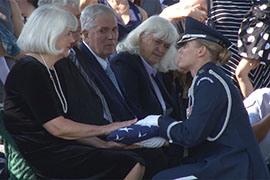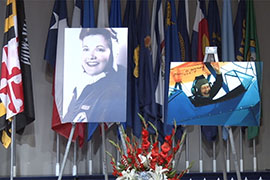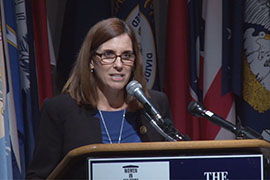- Slug: BC-CNS-Arlington WASPs,520
- Photo, video story available (thumbnail, caption below)
By SABELLA SCALISE and DILLION EDDIE
Cronkite News
ARLINGTON, Va. – In many ways, it was a typical Arlington National Cemetery funeral – there was a color guard and fly-over, a rifle salute, a carefully folded flag and the playing of “Taps.”
In other ways, it was not typical at all – no carriage, no grave and few, if any, tears.
“I’m actually very excited about today,” said Erin Miller, who was at Arlington on Wednesday for the inurnment of her grandmother, Elaine Harmon. “I know it seems weird because it’s a funeral, but we’ve been waiting for so long.”
Waiting to fulfill the dying wish of Harmon, one of a dwindling number of Women Airforce Service Pilots – WASPs – who flew military planes during World War II.
Harmon wanted Arlington to be her final resting place, something that had been possible for WASPs beginning in 2002. But last year, the Pentagon reversed that policy, saying that WASPs are considered to have served as civilians and that the decision to allow them at Arlington had never been properly approved – a decision that came down shortly before her death in April 2015 at age 95.
So Harmon’s ashes sat for a year in a suburban Maryland closet while her family and friends fought for this day.
Miller and her family took to social media to bring attention to the ban on WASPs, gaining attention from local and national media and getting more than 175,000 signatures on a change.org petition in support of their cause.
The petition grabbed the attention of Rep. Martha McSally D-Tucson, a former Air Force pilot who said WASPs were role models for her when she was coming up in the military.
She sponsored a bill to require that the Pentagon reverse its position. The bill, and a companion measure in the Senate, quickly gathered scores of cosponsors and passed in 20 weeks, being signed into law by the president in May.
There are fewer than 100 surviving WASPs, but all will now be able to apply to have their ashes inurned at Arlington.
“We were able to raise awareness and bring attention to this wrong, that these women were getting one last slap in the face,” McSally said Wednesday at the service.
It took an act of Congress to allow Wednesday’s ceremony, which McSally called a “momentous occasion.”
Besides family, dozens of current servicewomen and female veterans were on hand to thank Harmon’s family for what they have done and what it represents.
“We have a lot to owe to Elaine,” said Lt. Col. Caroline Jensen, a pilot in the Air Force Reserves who spoke at the service.
The service finished with McSally and Miller leading the rest of the room in the Air Force hymn “Off We Go into the Wild Blue Yonder.”
“We’re celebrating Elaine’s life and we are celebrating barriers being taken down for these women,” McSally said in her comments at the service.
They were also celebrating what Miller referred to as Harmon’s final flight.
“So today is about honoring my grandmother and the legacy of the WASP here at Arlington National Cemetery,” she said.
^__=
Web links:
_ Petition: https://www.change.org/p/congress-grant-wwii-women-airforce-pilots-military-honors-at-arlington-national-cemetery-d04e7e94-7b55-41ce-a809-34fc20eb62ee
_ Bill: https://www.congress.gov/114/plaws/publ158/PLAW-114publ158.pdf
^__=
Members of Elaine Harmon’s family are presented with a flag during an inurnment ceremony for the former Women Airforce Service Pilot at Arlington National Cemetery. (Photo by Claire Caulfield/Cronkite News)
Elaine Harmon was one of a dwindling number of Women Airforce Service Pilots – WASPs – who flew planes for training, transport and testing during World War II. (Photo by Claire Caulfield/Cronkite News)
Rep. Martha McSally, R-Tucson, a former Air Force pilot, said one reason she sponsored a bill to let WASPs back into Arlington National Cemetery was because of the support WASPs had shown her. (Photo by Claire Caulfield/Cronkite News)


